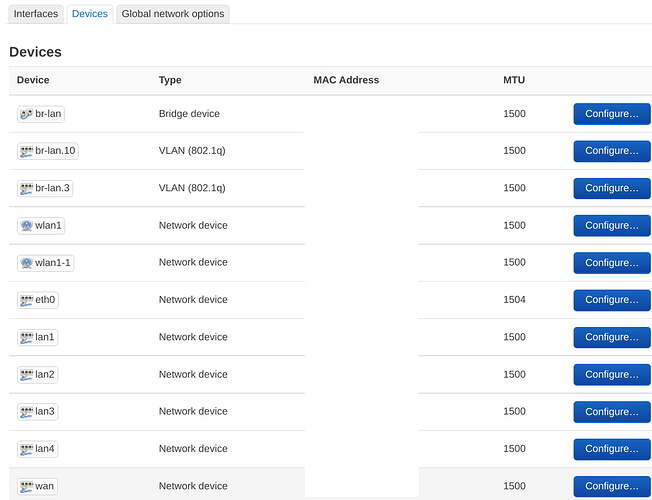As I said before, both WAN and CPU ports have address learning disabled, so no learning is involved in WAN to LAN, which may make a difference here.
You can try adding WAN port to another bridge to enable learning.
If that’s the case, why is the WAN to LAN path netting me full speed? Both WAN and CPU are not enabled with SA learning.
Edit: I would think this is probably a quirk of the mt7530/1 hardware.
Edit 2: While reading the spec, it appears that the ACL table also include link rate limit. Maybe auto learning sets the rate table properly?
The global ACL switch is on by default but it has a per-port switch which is off by default. Also there won't be any ACL rules after reset.
Does enabling LAN's VLAN filtering make a difference?
My bridge is vlan filtered. Only the wan port is stand-alone.
My understanding is the switch will build up the ACL when it learns.
Is there an easy way to change airtime scheduler from openwrt? Seems like driver related.
I run into a similar problem on a regular basis. Restarting radio0 for 2.4G helps. In the kernel log, from interesting things, I observe the following entries
167014.660438] device wlan0 left promiscuous mode
[167014.665114] br-lan: port 5(wlan0) entered disabled state
[167014.832227] mt7622-wmac 18000000.wmac: Message 000025ed (seq 13) timeout
[167014.839140] mt7622-wmac 18000000.wmac: Message 00002aed (seq 14) timeout
[167015.305356] br-lan: port 5(wlan0) entered blocking state
[167015.310767] br-lan: port 5(wlan0) entered disabled state
[167015.316530] device wlan0 entered promiscuous mode
[167015.321506] br-lan: port 5(wlan0) entered blocking state
[167015.326961] br-lan: port 5(wlan0) entered forwarding state
[167015.721544] br-lan: port 5(wlan0) entered disabled state
[167024.735905] IPv6: ADDRCONF(NETDEV_CHANGE): wlan0: link becomes ready
[167024.742584] br-lan: port 5(wlan0) entered blocking state
[167024.747992] br-lan: port 5(wlan0) entered forwarding state
Not from configuration changes. I have to prepare a patch to revert it back to the round-robin scheduler.
You may want to see if the suggestion posted here helps.
Hello all,
I have done a sysupgrade today.
The previous snapshot was from the end of December 2021. My 5 GHz WLAN is set to channel 44, mode AX and width 160 MHz. This ran so far without any problems. After the update today, however, no device has connected to the 5 GHz. Only when I set the MHz to 80, connections were possible again.
Is this a bug or do I have to set something else to get the 160 MHz working again?
@darksky : thanks, that works. Set it to auto and channel 104 is selected.
Devices now connecting.
Update: channel switched to 36. Nothing working. So I set the channel fix to 104.
I have the Belkin RT3200 since a few days in use as a standard router/AP.
I noticed this strange MTU number. Is this correct?
I have the same but not sure if right, got a fiber connection
This is from wikipedia:
The IP MTU and Ethernet maximum frame size are configured separately. In Ethernet switch configuration, MTU may refer to Ethernet maximum frame size. In Ethernet-based routers, MTU normally refers to the IP MTU. If jumbo frames are allowed in a network, the IP MTU should also be adjusted upwards to take advantage of this.
Since the IP packet is carried by an Ethernet frame, the Ethernet frame has to be larger than the IP packet. With the normal untagged Ethernet frame overhead of 18 bytes, the Ethernet maximum frame size is 1518 bytes. If a 1500 byte IP packet is to be carried over a tagged Ethernet connection, the Ethernet frame maximum size needs to be 1522 due to the larger size of an 802.1Q tagged frame. 802.3ac increases the standard Ethernet maximum frame size to accommodate this.
If MTU really means MTU in Openwrt how can it be bigger than 1500?
Wasn't there something DSA-related that on some devices (probably the CPU port intp the switch?) results in a larger apparent MTU in the device section? Some sort of data tag required for DSA. On my recent snapshot I see 1508 for eth0...
Good evening @darksky!
The new leads I use are as follows, purchased on Amazon: https://www.amazon.com/gp/product/B07MM88N6J/ref=ppx_yo_dt_b_asin_title_o00_s02?ie=UTF8&psc=1
In terms of performance (remembering I'm in a pretty adverse environment: condo, many FIOS routers around me, etc... at a little over 20 yards, I was at about 60-70Mbps with my TP-Link Archer C1900, 100-120Mbps with the RT3200 stock, and 150-170Mbps with RT3200 with the new antennas/leads.
Have others been experiencing sudden drops of WiFi connectivity on the RT3200? I started a new thread to keep this one a bit more tidy. Would appreciate any comments/suggestions/insights in the new thread.
No. My E8450 is running with learning enabled for now. Monitoring for issues.
Edit: Previously I tried add the wan port to br-lan and set it up with vid 2, with lan as 1. It’s not stable. I’ll loose IPv6 wan after a while. But that without the recent VLAN patches. So my E8450 is setup with vlan filtering for lan ports and bridge only.
Is it me or OpenWRT on this router, gives you mixed speed?
I tried the cake script, was getting a whopping 3mbps. then I try software AND hardware offloading with IRQ enabled both times (IRQ and cake, fyi). was okayish, getting around 400mbps. now no matter what I do, the speed is always slow. with the cake script or without. IRQ doesn't seem to help, well, not sure if it does at all.
I was testing with the waveform buffer bloat, with cake/sqm it would never go above 80mbps but on a speedtest site it was maxed out at 400mbps. I have a unlimited 1gbps line.
I tried with just packet sheering, IRQ and software offloading and it was around 500mbps. added hardware to that made no difference.
I purchased this router because it was recommended, now I'm starting to think it was £90 waste.
Thoughts?


